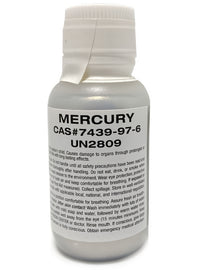Mercury Metal
The Only Elemental Metal That Is Liquid At Room Temperature
About Mercury Metal
Mercury is a heavy, silvery liquid at standard temperature and pressure, the only d-block element that is liquid under these conditions. It occurs naturally as Mercury Sulfide (aka cinnabar), or less commonly as other mineral species, and has a long history of use in pharmaceuticals and cosmetics. Since it does not easily permeate unbroken skin, mercury metal is not especially toxic upon contact; however, it vaporizes easily and is toxic upon inhalation and ingestion. The widespread applications of mercury metal have been partially reduced due to concerns over its toxicity, but it remains useful in a variety of industries. For example, mercury has been phased out of use in measuring devices like thermometers, barometers/manometers. It is still used in research laboratories, gold and silver processing, dental restoration, starch extraction, and in rarer cases, pharmaceuticals.
Common Uses and Applications
- Reagent
- Thermometers
- Dental restoration
- Gold/silver processing
- Mercury switches
- Fluorescent lamps
- Starch extraction
- Pharmaceuticals





